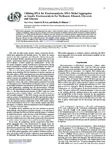|
|
Creator | Title | Description | Subject | Date |
| 326 |
 |
Armentrout, Peter B. | Translational energy dependence of Ar+ + XY → ArX+ + Y (XY = H2, D2, HD) from thermal to 30 eV c.m. | Cross sections for the reactions of Ar+ with H2, D2, and HD to form ArH + and ArD + are measured using a new guided ion beam tandem mass spectrometer which affords an experimental energy range from 0.05 to 500 eV laboratory. The apparatus and experimental techniques are described in detail. Cross se... | Translational energy; Ion-molecule reactions; Ion energy; Argon; Hydrogen; Endothermic reactions | 1985 |
| 327 |
 |
Armentrout, Peter B. | Translational energy dependence of O+(4S) + N2 → NO+ + N from thermal energies to 30 eV c.m. | Guided ion beam mass spectrometry is used to examine the kinetic energy dependence of the reaction of ground state atomic oxygen ion with molecular nitrogen. An 0 + (4S) source which produces less than 0.06% excited states is described. Cross sections for the NO+ + N product channel decrease with... | Ion-molecule reactions; Translational energy; Threshold behavior; Endothermic reactions; Nitrogen; Oxygen | 1987 |
| 328 |
 |
Poulter, Charles Dale | Trisammonium geranyl diphosphate | Geranyl chloride. To a flame-dried, 100-mL, three-necked, round-bottomed flask equipped with a magnetic stirrer, low temperature thermometer, rubber septum, and nitrogen inlet adapter, is added 1 .47 g (11 mmol) of N-chlorosuccinimide (Note 1) . The powder is dissolved in 45 mL of dry dichloromet... | Buffer; Solution; Chloride | 1987 |
| 329 |
 |
Miller, Joel Steven | Two-dimensional molecular-based ferrimamagnets incorporating decamethylmetallocenium cations | Four new molecular-based magnets have been synthesized, and their magnetic properties have been investigated in detail. Their formulae are [M'(C5Me5)2]2M2[Cu(opba)]3.(DMSO)x(H20)y with M' = Fe, M = Mn, x = 5, y = 4 (1), M' = Fe, M = Co, x = 6, y = 4 (2), M' = Co, M = Mn, x = 5.5, y = 4 (3) and M' = ... | Magnetic; Compounds | 1996 |
| 330 |
 |
Morse, Michael David | Two-photon ionization spectroscopy and all-electron ab initio study of LiCa | Resonant two-photon ionization spectra of LiCa have been obtained from a laser vaporization, supersonic expansion source. The ground state of the molecule is confirmed to be X 2?+. Three band systems have been observed near 15 282, 19 310, and 22 250 cm-1 and the upper states have been assigned as 2... | | 1998 |
| 331 |
 |
Morse, Michael David | Ultraviolet photoelectron spectroscopy of molybdenum and molybdenum monoxide anions | The 351 nm photoelectron spectra of Mo-and MoO- have been measured. The electron affinity of atomic molybdenum is 0.748(2) eV and that of molybdenum monoxide is 1.290(6) eV. The term energies of several MoO electronic states not previously observed are obtained and compared with ab initio prediction... | | 1995 |
| 332 |
 |
Miller, Joel Steven | Using fission | Atoms are just like people, both are lazy. Energy is a measure of work, i.e., more work implies more energy. Atoms do not like to work, hence they try to reduce the energy in their atomic system. For different elements the energy reduction occurs by reaction, e.g., an energetic sodium atom reacts w... | Uranium-235; Uranium-238 | 1966 |
| 333 |
 |
Minteer, Shelley D. | Utilizing DNA for electrocatalysis: DNA-Nickel aggregates as anodic electrocatalysts for methanol, ethanol, glycerol, and glucose | DNA-nickel aggregates were electrodeposited onto glassy carbon electrode surfaces and have shown electrocatalytic activity for oxidation of methanol, ethanol, glycerol, and glucose at room temperature in alkaline solutions. Bulk electrolysis oxidation products identified by 13C NMR include carbonate... | | 2013-01-01 |
| 334 |
 |
Morse, Michael David | Vibronic spectroscopy of unsaturated transition metal complexes: CrC?H, CrCh?, and NiCH? | Vibronically resolved resonant two-photon ionization and dispersed fluorescence spectra of the organometallic radicals CrC2H, CrCH3 , and NiCH3 are reported in the visible and near-infrared wavelength regions. For CrC2H, a complicated vibronic spectrum is found in the 11 100?13 300 cm-1 region, with... | | 2004 |
| 335 |
 |
Miller, Joel Steven; Epstein, Arthur J. | Viscous behavior in a quasi-1D fractal cluster glass | The spin glass transition of a quasi-1D organic-based magnet ([MnTPP][TCNE]) is explored using both ac and dc measurements. A scaling analysis of the ac susceptibility shows a spin glass transition near 4 K, with a viscous decay of the thermoremanent magnetization recorded above 4 K.We propose an ex... | Transition; Magnet; Magnetization | 2002 |
| 336 |
 |
Miller, Joel Steven; Epstein, Arthur J. | X-ray observation of crossover of 2kF to 4kF scattering in (N-Methylphenazinium)x(Phenazine)1-x(Tetracyanoquinodimethane) [(NMP)x(Phen)1-x(TCNQ)], 0.5 (< _x <_ 1.0) | We report the temperature-dependent x-ray diffuse scattering of (NMP),(Phen)(1-x-)(TCNQ) as a function of conduction-electron density (x). With decreasing x three different unique electronic instability regimes are successively observed on the TCNQ chains: (i) the 2kF instability for (2/3<_x<_1, (ii... | Conduction-electron; Electron density; Chain | 1982 |
| 337 |
 |
Poulter, Charles Dale | Yeast squalene synthase. A mechanism for addition of substrates and activation by NADPH | Squalene synthase catalyzes the condensation of two molecules of farnesyl diphosphate (FPP) to give presqualene diphosphate (PSPP) and the subsequent reductive rearrangement of PSPP to squalene. Previous studies of the mechanism of addition of FPP to the enzyme have led to conflicting interpretation... | Enzyme Activation; Sesquiterpenes; Kinetics | 1993-04-15 |
| 338 |
 |
Miller, Joel Steven | Zero field splitting, field-dependent magnetization of mixed-valent S = 3/2 Diruthenium(II,III) tetracarboxylates | The 2 K field-dependent magnetization, M(H), of S = 3/2 [RunII/III2(OAc)4]+ was studied. [RuII/III 2(OAc)4]+ exhibits an unusually low magnetization with respect to that predicted by the classical Brillouin function. This reduced value is a consequence of the large anisotropy arising from the large ... | Spin; Coupling; Expressions | 2004 |













